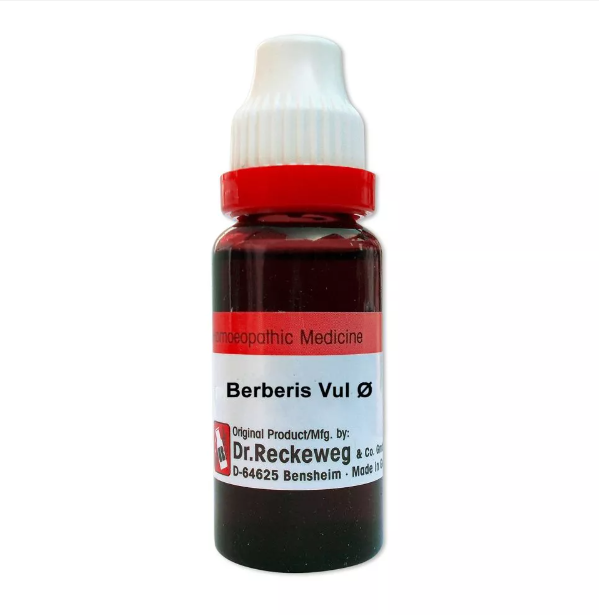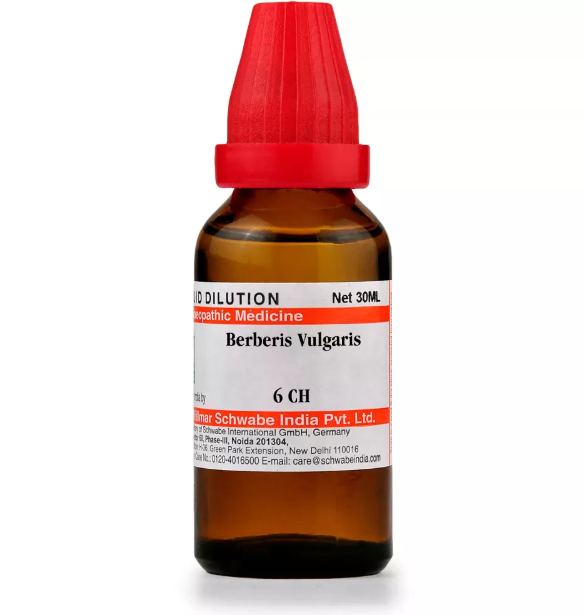BERBERIS VULGARIS Q, 6C, 12C, 30C, 200C, 1M, 10M USES AND SYMPTOMS
 Berberis vulgaris, commonly known as Barberry, is characterized by rapid changes in symptoms and pain sensations, alternating between thirst and thirstlessness, hunger and loss of appetite. It strongly affects the venous system, leading to pelvic engorgements and hemorrhoids. It is beneficial for hepatic and rheumatic conditions, especially when accompanied by urinary, hemorrhoidal, and menstrual issues. It is particularly suited for individuals with old gouty constitutions and excels in addressing renal and bladder problems, gall stones, and cystitis. Its influence extends to the liver, promoting bile flow, and it is often indicated in arthritic conditions with urinary disturbances. Berberis is most suitable for fleshy individuals with robust livers but low endurance. It is effective in alleviating spinal irritation and its pains typically radiate, worsening with various movements, especially standing and active exercise.
Berberis vulgaris, commonly known as Barberry, is characterized by rapid changes in symptoms and pain sensations, alternating between thirst and thirstlessness, hunger and loss of appetite. It strongly affects the venous system, leading to pelvic engorgements and hemorrhoids. It is beneficial for hepatic and rheumatic conditions, especially when accompanied by urinary, hemorrhoidal, and menstrual issues. It is particularly suited for individuals with old gouty constitutions and excels in addressing renal and bladder problems, gall stones, and cystitis. Its influence extends to the liver, promoting bile flow, and it is often indicated in arthritic conditions with urinary disturbances. Berberis is most suitable for fleshy individuals with robust livers but low endurance. It is effective in alleviating spinal irritation and its pains typically radiate, worsening with various movements, especially standing and active exercise.
Head: Listless, apathetic, indifferent. Puffy sensation, feels as if the head is becoming larger. Vertigo with attacks of fainting. Frontal headache. Chills in the back and occiput. Tearing pains in the auricle and gouty concretions. Sensation of a tight cap pressing upon the whole scalp.
Nose: Dry; obstinate catarrh of left nostril. Crawling sensation in the nostrils.
Face: Pale, sickly. Sunken cheeks and eyes, with bluish circles.
Mouth: Sticky sensation. Diminished saliva. Sticky, frothy saliva, like cotton (Nux-m.). Tongue feels scalded; vesicles on the tongue.
Stomach: Nausea before breakfast. Heartburn.
Abdomen: Stitches in the region of gall bladder; worse, pressure, extending to the stomach. Catarrh of the gall bladder (cholecystitis) with constipation and yellow complexion (jaundice). Stitching pains in front of the kidneys extending to the liver, spleen, stomach, groins and Poupart’s ligament. Sticking pain, deep in the ilium.
Stool: Constant urging to stool. Diarrhea painless, clay colored, burning and smarting in anus and perineum. Tearing around the anus. Fistula in ano.
Urinary: Burning pains. Sensation as if some urine remained after micturating. Urine with thick mucus and bright red, mealy sediment.’ Bubbling, sore sensation in kidneys. Pain in the bladder region. Pain in the thighs and loins on micturating. Frequent micturition; urethra burns when not micturating (urethritis).
Male: Neuralgia of spermatic cord and testicles. Smarting, burning, stitching in the testicles, prepuce and scrotum.
Female: Pinching constriction in mons veneris, vaginismus, contraction and tenderness in the vagina. Burning and soreness in vagina. Desire diminished, cutting pain during coition (dysparunia). Menses scanty, gray mucus with pain in kidneys and chilliness, pain extends down the thighs. Leucorrhea, grayish mucus, with painful urinary symptoms. Neuralgia of ovaries and vagina.
Respiratory: Hoarseness; polyp in the larynx. Tearing stitches in the chest and region of heart.
Back: Stitches in the neck and back; worse, respiration. Sticking pain in the region of kidneys radiating around the abdomen, to the hips and groins. Numb, bruised sensation. Stitches from kidneys to the bladder. Tearing, sticking pain with stiffness, making rising difficult, involving hips, nates, limbs, with numbness. Lumbago (Rhus-t., Ant-t.). Metatarsus and metacarpus feel sprained. Post-operative pain in the lumbar region; soreness with sharp pain following the course of circumflex iliac nerve to the bladder with frequent micturition.
Extremities: Rheumatic paralytic pain in the shoulders, arms, hands and fingers, legs and feet. Neuralgia under the finger nails, with swelling in finger joints. Sensation of coldness on the outside of thighs. Heels painful, as if ulcerated. Stitching between the metatarsal bones as if from a nail when standing. Pain in the balls of feet on stepping. Intense weariness and lameness of legs after walking a short distance.
Fever: Cold sensations in various parts, as if spattered with cold water. Warmth in the lower part of back, hips, and thighs.
Skin: Flat warts. Itching, burning and smarting; worse, scratching; better, cold applications. Small pustules all over the body. Eczema of anus and hands. Circumscribed pigmentation following eczematous inflammation.
Modalities: Worse, motion, standing. It brings on, or increases, urinary complaints.
Relationship: Compare: Ipomoea bona-nox-Convo-d.-Morning glory (pain in the left lumbar muscles on stooping. Kidney disorders with pain in the back. Marked abdominal flatulence. Aching on top of the right shoulder; renal colic; aching in the lumbar region and extremities), Aloe, Lyc., Nux-v., Sars. Xanthorrhoea arborea (severe pain in kidneys, cystitis and gravel. Pain from the ureters to the bladder and testicles; pain in the lumbar region returns from least chill or dampness). Xanthorrhiza apifolia-Shrub yellow root-contains Berberine. Dilatation of stomach and intestines, atony, enlarged spleen. Antidotes: Camph., Bell.
Dose: Tincture to sixth potency.
SYMPTOMS OF BERBERIS VULGARIS
Head:
Listless, apathetic, feels head enlarging.
Vertigo with fainting attacks, frontal headache.
Chills in back and occiput, tearing pains in auricle.
Nose:
Dry; persistent left nostril catarrh, crawling sensation.
Face:
Pale, sickly, sunken with bluish circles.
Mouth:
Sticky, diminished saliva, scalded tongue, vesicles.
Stomach:
Nausea before breakfast, heartburn.
Abdomen:
Gall bladder stitches, extending to stomach.
Catarrh, constipation, jaundice; deep ilium pain.
Stool:
Urging, painless diarrhea, burning anus, fistula.
Urinary:
Burning, incomplete urination, thick mucus, hematuria.
Bladder pain, burning urethra outside urination.
Male:
Neuralgia, burning in spermatic cord, testicles.
Female:
Vaginal constriction, burning, dyspareunia, scanty menses.
Respiratory:
Hoarseness, chest stitches, polyp.
Back:
Neck, back stitches; lumbar pain radiating to hips.
Extremities:
Rheumatic pain, neuralgia, cold thighs, painful heels.
Fever:
Cold sensations, warmth in lower back, thighs.
Skin:
Warts, itching, burning, pustules, eczema.
Modalities:
Worse with motion, standing; exacerbates urinary issues.
Relationship:
Compare with Ipomoea bona-nox, Aloe, Lyc., Nux-v., Sars.
Dose:
Tincture to sixth potency.
selection of the potency
Individualization:
- Homeopathy is based on the principle of treating the individual, not just the disease. The unique symptoms and characteristics of the person are crucial in determining the most suitable potency.
Intensity of Symptoms:
- The intensity of the symptoms guides the choice of potency. If the symptoms are intense and acute, a lower potency (e.g., 6C, 30C) might be considered. For chronic conditions with less intensity, higher potencies (e.g., 200C, 1M) may be appropriate.
Sensitivity of the Patient:
- Some individuals are more sensitive to homeopathic remedies, while others may require higher potencies. The practitioner considers the patient’s sensitivity when selecting the potency.
Acute vs. Chronic Conditions:
- Lower potencies are often used for acute conditions, while higher potencies may be considered for chronic or long-standing issues.
Previous Response to Potencies:
- The patient’s response to previous homeopathic treatments helps guide the choice of potency. If a particular potency has been effective in the past, it may be repeated or adjusted as needed.
Vital Force and Susceptibility:
- Homeopathy views illness as a disturbance in the vital force. The practitioner assesses the patient’s overall vitality and susceptibility to determine the appropriate potency.
Aggravation or Amelioration:
- The direction of the symptom response (aggravation or amelioration) after taking a remedy can influence the choice of potency.
Miasmatic Considerations:
- In classical homeopathy, the concept of miasms (inherited disease tendencies) is considered. The practitioner take this into account when selecting the potency.
Practitioner Experience:
- The experience and preference of the homeopathic practitioner play a role. Some practitioners may have success with certain potencies based on their clinical experience.
SAFETY INFORMATION
- Do not exceed the recommended dose by physician
- Keep out of the reach of children
- Store in a cool dry place away from direct sunlight
- Maintain half an hour gap between food/drink/any other medicines and homoeopathic medicine
- Avoid any strong smell in the mouth while taking medicine e.g. camphor, garlic, onion, coffee, hing
Medicine images use for reference only selection of homeopathic medicine depends on the individual’s specific symptoms and overall constitution. Moreover, homeopathy is a holistic system of medicine that treats the individual as a whole. In addition to addressing the physical symptoms, it takes into account the emotional and mental state of the person. Consequently, it’s crucial to consult with a qualified homeopathic practitioner for personalized treatment.
The information provided on this website is intended solely for educational purposes. Always seek the advice of your physician or other qualified health provider.
